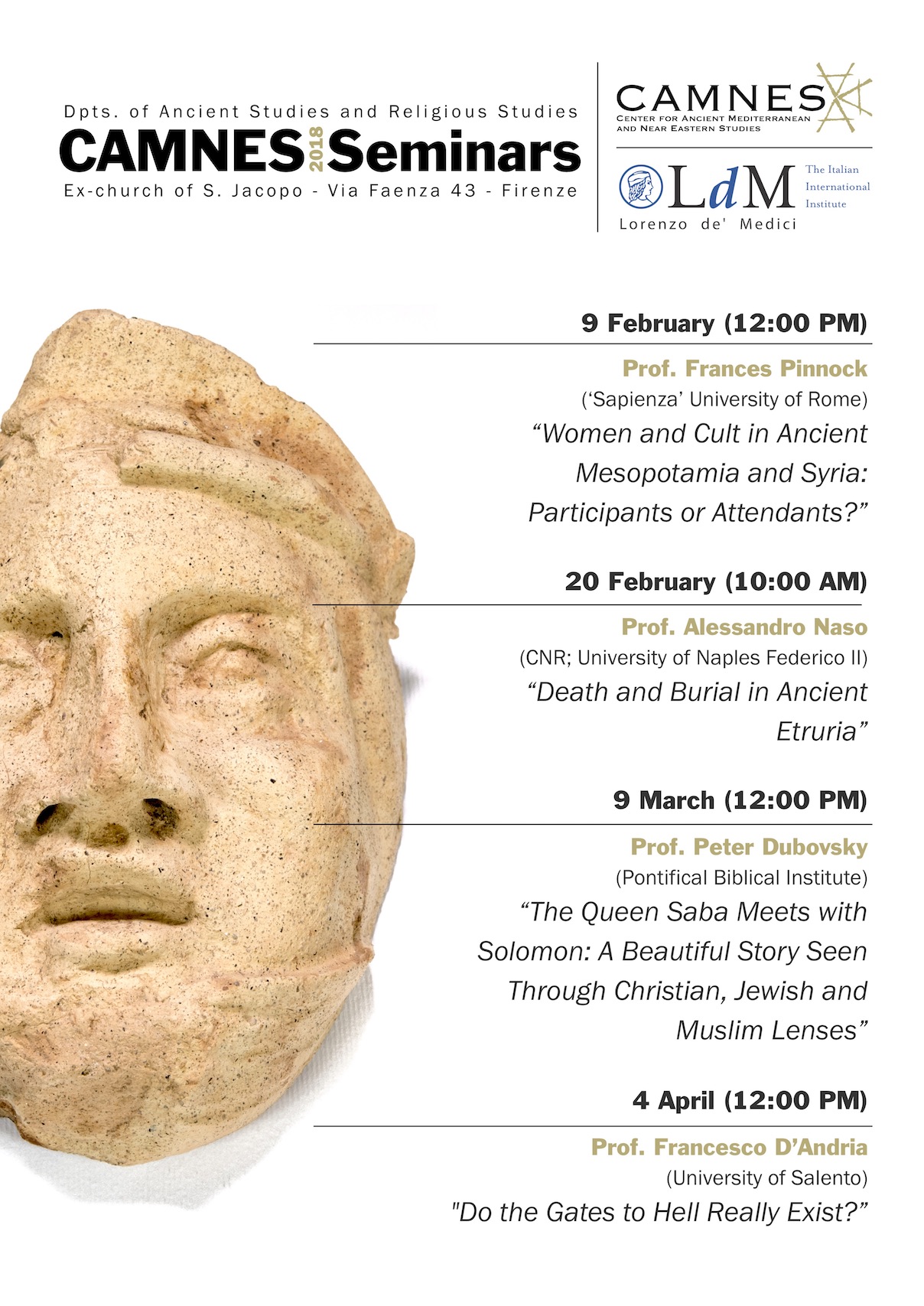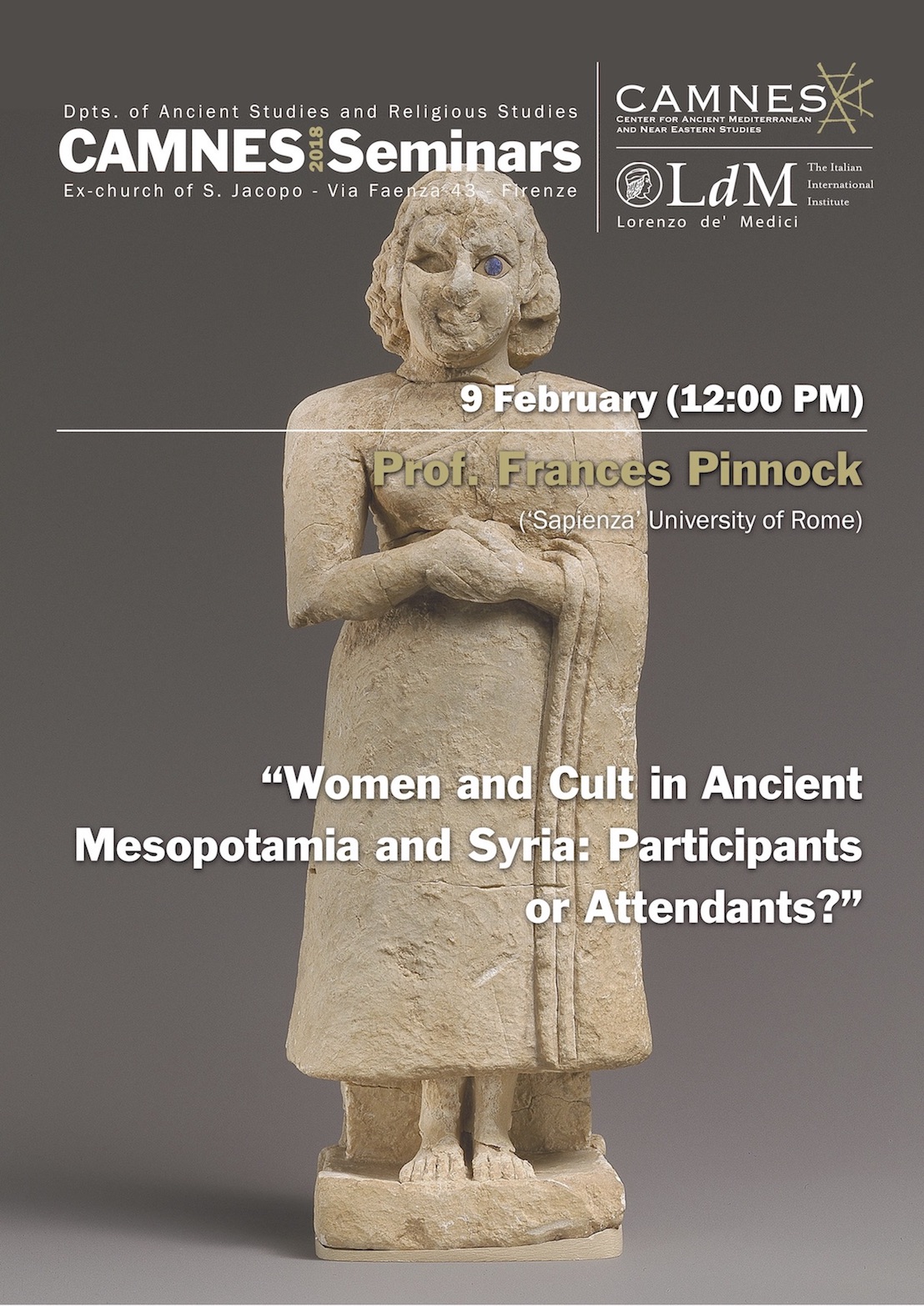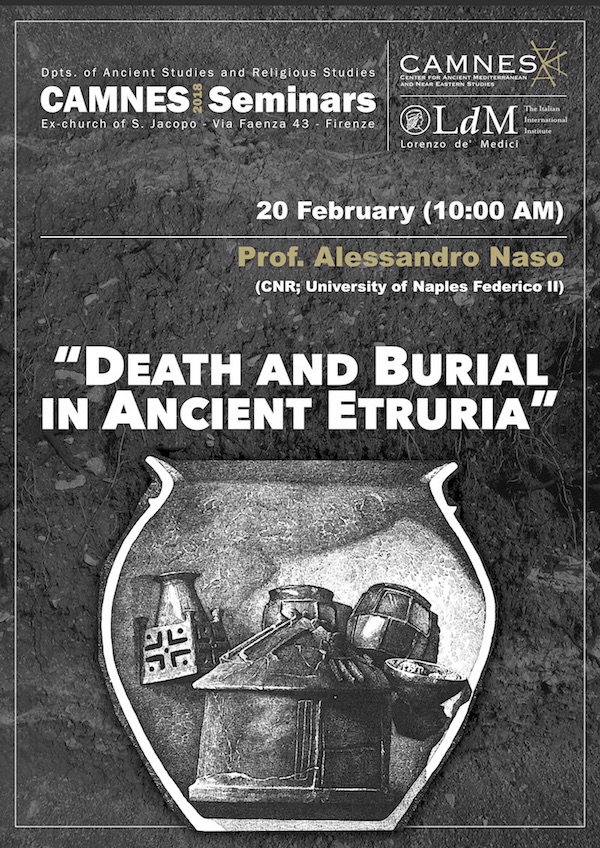A seminar series open to the public held by leading scholars for the LdM academic program of the 'Ancient Studies' and 'Religious Studies' departments
CAMNES and the Lorenzo de' Medici Institute, starting in SPRING 2018, organize a series of seminars open to the public held by leading academic scholars in the fields of the ancient Near East, the ancient Mediterranean and Religious studies for the academic program of the departments of 'Ancient Studies' (ANC) and 'Religious Studies' (REL).
All seminars will take place within the LdM premises of the ex-church of S. Jacopo in Campo Corbolini situated in via Faenza 43 in Florence (Italy). Free entrance.
CAMNES Seminars
SPRING 2018
Prof. Frances Pinnock
(‘Sapienza’ University of Rome)
“Women and Cult in Ancient Mesopotamia and Syria: Participants or Attendants?”
Prof. Alessandro Naso
(CNR; University of Naples Federico II)
“Death and Burial in Ancient Etruria”
Cemeteries are our greatest source of knowledge of the Etruscans, because the Etruscan elite furnished their tombs very richly, a “barbarian” custom that they adopted throughout their civilization, from the second half of the eighth century BCE onward. The three major arts—sculpture, architecture, and painting—were developed mostly for use in burials. Although (or because) this constitutes a huge amount of information, a detailed study of death and burial in Etruria is still lacking; the various reviews of aspects of the whole subject, usually involving a single site or a particular period in history, show that the development of a funerary ideology is closely connected to contemporary religion and society. Funerary ideology is a traditional and conservative matter. Up-to-date analyses of single sites specifically concern the Iron Age and the Orientalizing period, while the more complex Archaic and Late Archaic periods are less well known. From the Classical period onward the emergence of a precise view of the underworld can be followed, influenced by Greek conceptions of its geography: the ferryman Charon, ferrying the dead across the river Acheron to the hereafter, was adopted as Charun in Etruscan culture, where further male and female demons of their own peopled the underworld.
A. Naso, Death and burial, in Etruscology, ed. by A. Naso, Berlin-Boston 2017, 317-339 with further lit.
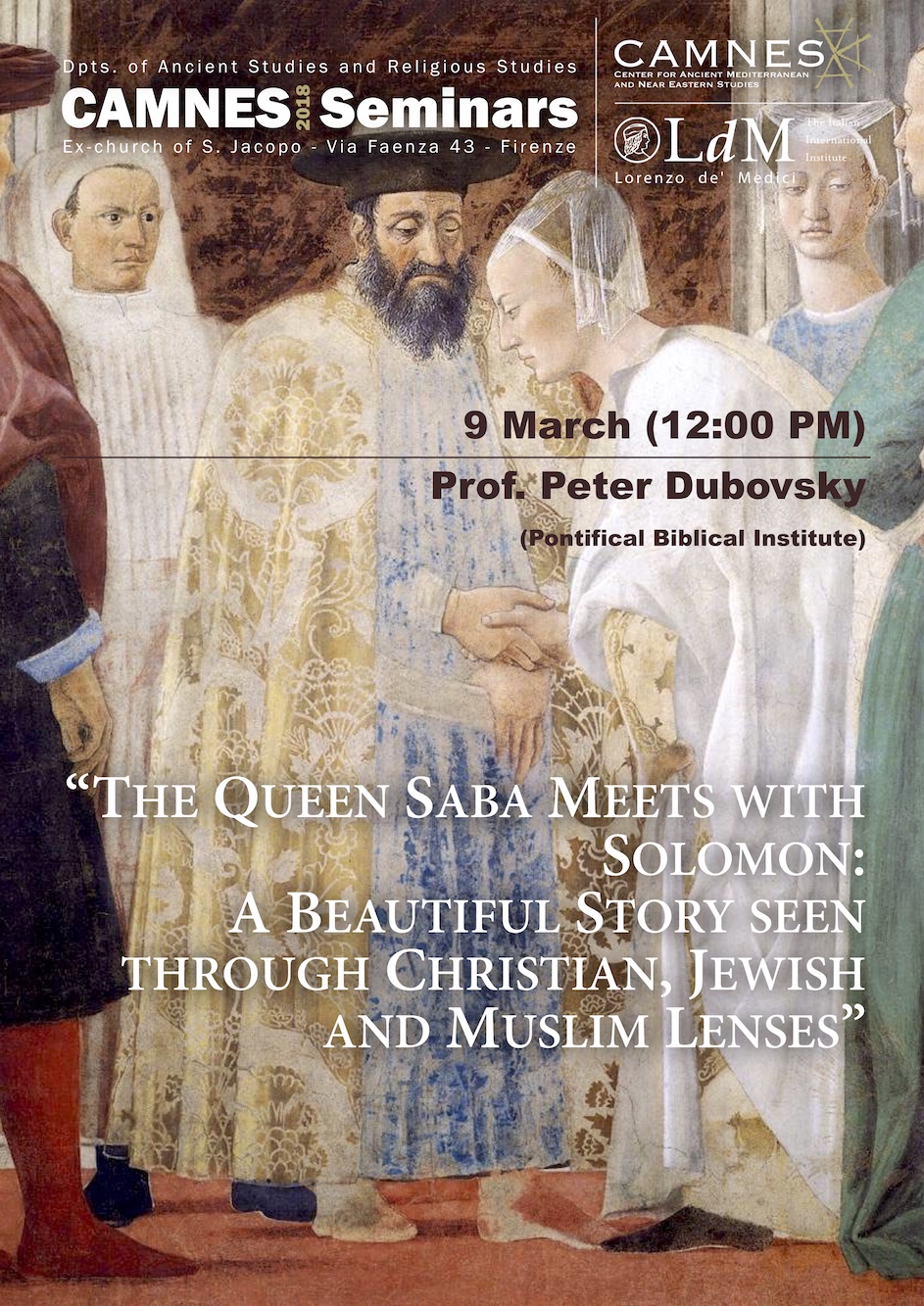 9 March (12:00 PM)
9 March (12:00 PM)
Prof. Peter Dubovsky
(Pontifical Biblical Institute)
“The Queen Saba Meets with Solomon: A Beautiful Story Seen Through Christian, Jewish and Muslim Lenses”
This paper will investigate the story described in 1 Kgs 10. My paper will start with the historical, exegetical, and linguistic background of the story and then we will go through the reception of the story in three major traditions.
Bibliography:
Elias, Jamal J. "Prophecy, Power and Propriety: The Encounter of Solomon and the Queen of Sheba." JQS 11, no. 1 (2009): 57-74.
Lassner, Jacob. Demonizing the Queen of Sheba : Boundaries of Gender and Culture in Postbiblical Judaism and Medieval Islam. Chicago: The University of Chicago Press, 1993, 161-214.
de Pury, Albert. "Salomon Et La Reine De Saba. L'analyse Narrative Peut-Elle Se Dispenser De Poser La Question Du Contexte Historique ?". In La Bible En Récits : L'exégèse Biblique À L'heure Du Lecteur : Colloque International D'analyse Narrative Des Textes De La Bible, Lausanne (Mars 2002), edited by Daniel Marguerat. Le Monde De La Bible, 213-38. Genève: Labor et fides, 2003.
Raineri, Osvaldo, Renata Riva, and Yohannes Tesemma. Kebra Nagast = La Gloria Dei Re : Salomone E La Regina Di Saba Nell'epopea Etiopica Tra Testo E Pittura. Roma: Fondazione Benedetta Riva, 2008.
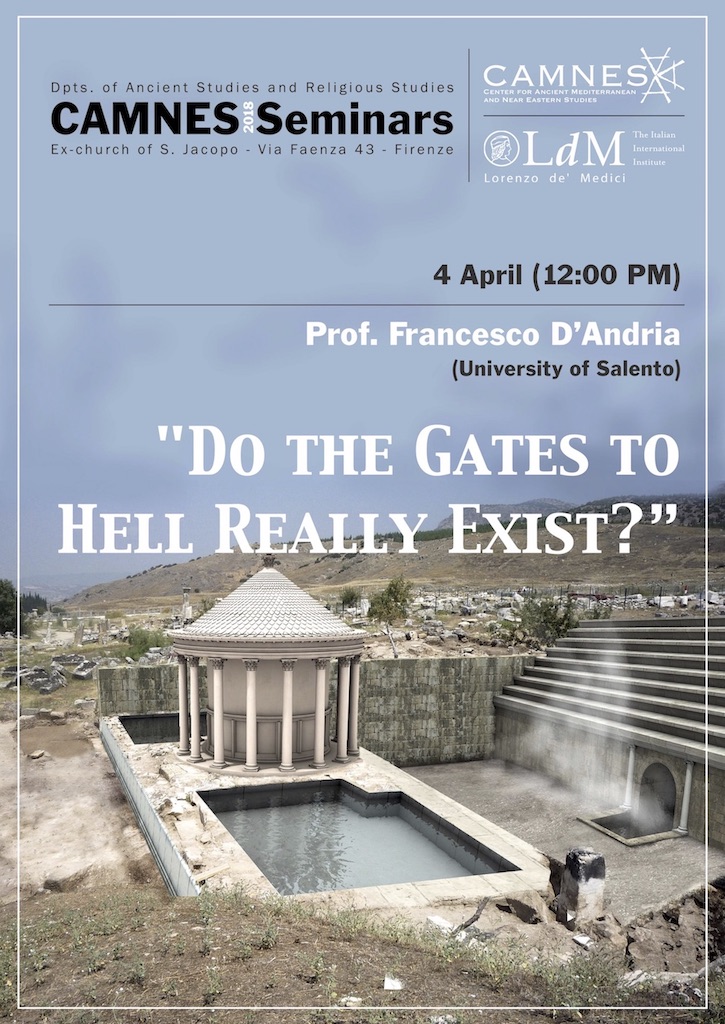 4 Aprile (12:00 PM)
4 Aprile (12:00 PM)
Prof. Francesco D’Andria
(University of Salento)
"Do the Gates to Hell Really Exist?”
The lecture represents a journey about the myth of the Door of the Underworld in literature, the visual arts and music, in light of the archaeological discoveries that have allowed archaeologists to recognize in the ancient site of Hierapolis (near Pamukkale in western Turkey) a sanctuary dedicated to the god of the underworld Pluto/Hades indicated as “Ploutonion” by the ancient Greeks and Romans. It was built over a cave in which a thermal spring and deadly fumes of carbon dioxide (i.e., CO2) occurred. During his lecture, Prof. D’Andria will also analyze images of the medieval and Renaissance cycles of Italian art (Lorenzetti, Mantegna) associated with the description of the underworld and then he will move on to the myth of Orpheus and his journey to the underworld described by the music of Monteverdi and Gluck. The theme of the relationship between natural phenomena and myths and the impact that the mortal gases of the subsoil have had on the collective imaginary, in particular CO2. As evidenced by the novel written by Dan Brown “Inferno”, in antiquity as well as in the contemporary world, the production of CO2 is an extraordinary negative element that, for example, is at the base of contemporary global warming and the greenhouse effect.
Seminars venue


